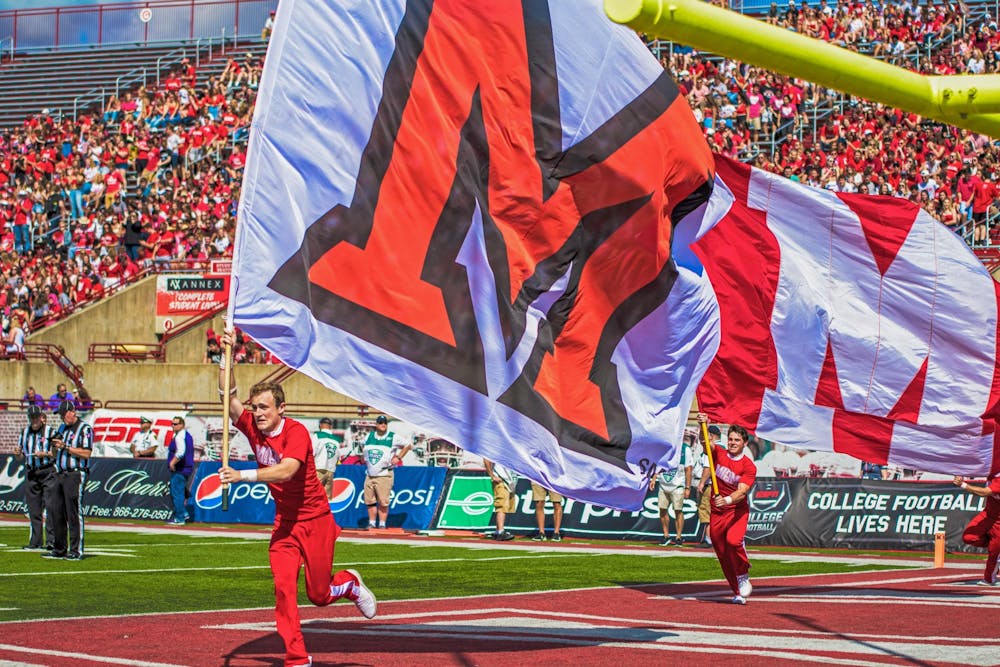Hours after the career fair, underneath Millett Hall, down a winding staircase and behind a passcode-locked door, Miami University’s cheerleading team begins its two-hour practice.
It’s the first practice after the team’s trip to the Universal Cheerleaders Association (UCA) National Championship competition during J-term.
Normally, the team practices on the main floor of Millett, but because the space was transformed for career fair, the cheerleaders moved underground.
Aside from the lack of windows, the practice space, known as the sub-gym, lacks any subterranean feeling. It looks exactly like a typical gymnasium: a full-size basketball court, white walls with hanging memorabilia and padding along the perimeter.
Rap beats pump out of the sub-gym’s speakers as the team practices. At the center of the room, boys stand red-faced. Repeatedly throwing smiling girls into the air, their faces tense and relax at a rhythmic pace.
It’s a game of constant concentration. One wrong move and the girl comes crashing down.
This is Miami cheerleading.
In the team’s second UCA National Championship run in the last 20 years, Miami took twelfth place out of the 22 schools in the division.
“It takes a ton of work, and it takes a ton of sacrifice,” said Jerel Stewart, Miami’s head cheerleading coach. “Once you go out there, we have one chance to compete for two minutes and 30 seconds, and it’s just nuts … No matter how you place, you know you gave it your all.”
Stewart has been a coach for his entire post-collegiate life, but he has been a part of the cheerleading world for much longer.
“I was a gymnast first,” Stewart said. “And then when I got into college, I went to a small university first, Otterbein University … and then the cheer coach actually saw me just do a flip, and then of course she was like, ‘We’ll give you some money if you join our team.’ So it was a little friendly bribe there.”
“Once you’re in cheerleading,” Stewart added, “you’re pretty much hooked for life.”
Enjoy what you're reading?
Signup for our newsletter
Stewart recruited nine of his male friends to join Otterbein’s all-female cheer team with him, so he knows firsthand about the stigma surrounding boys in cheerleading. But he explained cheerleading requires just as much athletic ability as other male-dominated sports.
“You get a lot of ex-athletes, who may not be getting a football scholarship, who may not be playing scholarship sports here at Miami, but definitely still want that athletic feel,” Stewart said.
“Once they do come in and try it and figure it out and I tell them what cheerleading actually is, they’re like, ‘I had no idea! This is a whole different world,’ And then they kind of get hooked.”
Dane Doebereiner, a sophomore marketing and interactive media studies double major, began cheerleading in college. He was a self-described theater kid until college cheerleading.
“I basically just walked on with no prior experience, with no prior knowledge of what the cheer world was,” Doebereiner said. “Now, it’s my second year here and just knowing how deep and how far the cheer world goes in without actually knowing that it's even there when you don’t get introduced to it is crazy.”
Doebereiner said Miami cheerleading is more than just a team. Kassandra Strahler, a sophomore early childhood education major, said the same.
“For those two minutes and 30 seconds, your mind is completely blank,” Strahler said. “You’re not thinking about yourself, you’re doing it for everyone else. It’s that mindset that’s so rare to have. You have to be able to put your team before yourself.”
The team’s family dynamic is apparent, even when new members are added to the mix.
At it’s first practice after the UCA National Championship, the cheerleading team welcomed new members. Veterans taught their potential new teammates how to properly complete lifts. After each attempt, both failed and successful, words of encouragement echoed through the gym.
“You will never succeed in this sport if you don’t learn how to take correction, because it’s somebody’s life you’re holding,” Strahler said. “If you don’t have complete trust in the person that’s holding you, you will never succeed as a team.”
Forty-five minutes into practice, Doebereiner and Strahler practiced lifting together.
Strahler flew into the air, being held up by only Doebereiner’s grip on her two feet. After balancing herself, Strahler lifted one foot into the air, holding it in her hand.
Doebereiner inhaled deeply, his face reddening with each passing moment. He pushed Strahler upward and removed one of his hands from her foot.
Strahler now balanced on one foot, standing on only one of Doebereiner’s hands. A smile spread across her face.
The rest of the team took notice and began to cheer on the duo. With one final upward push, Strahler flew up and back down, assisted in her landing by Doebereiner and two other cheerleaders.
Doebereiner and Strahler congratulated each other with a high-five and an embrace after completing the lift, but the pair weren’t the only ones feeling the joy. Other cheerleaders congratulated them and encouraged each other to keep working hard.
“You gotta have a team who is confident in each other to throw the same stunt and hit it the same way,” Doebreiner said.
Strahler interjected.
“It’s all or nothing.”




